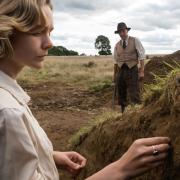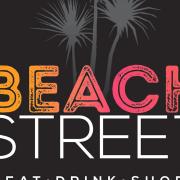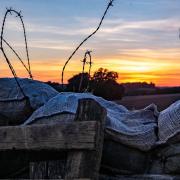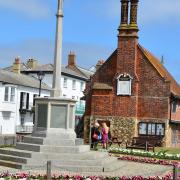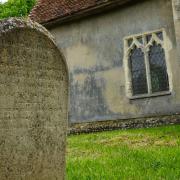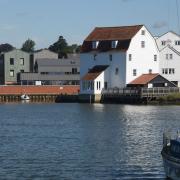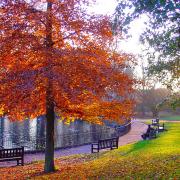All across Suffolk the National Trust is working to protect some of the county’s most important natural sites and manmade locations – we’ve rounded up 10 that you need to visit
Located smack bang in the middle of an Area of Outstanding Natural Beauty, this incredible landscape - described as 'quiet and serene, wild and dramatic' - is a dream for any photographer.
As well as being a haven for a number of animal species - rare birds like the Dartford warbler and nightjar share the area with antlions and adders - humans will find plenty of things to do with the family. Walks criss-cross the heather-covered area, the kids can go bug hunting or den building and dogs are free to roam the beach without a lead year round. After all that excitement, a cliff-top tea room will be waiting to provide you with refreshments and majestic views.
2) Theatre Royal Bury St Edmunds
Built in 1819, this Grade I listed theatre has endured a number of closures and periods of gloom yet many original features still remain intact. The building was given into the care of the National Trust in 1975 and during the mid 2000s it was restored to its original glory, ensuring its status as Britain's only surviving regency playhouse.
Throughout its lifetime the theatre has held a reputation for pioneering new forms of theatrical performance and today, under the stewardship of Bury St Edmunds Theatre Management, it still gives our county's finest talent the chance to flourish on the finest possible stage.
3) Melford Hall
Starting life as an expansion of medieval buildings belonging to the abbots of Bury St Edmunds, this grand home has passed through the hands of several different notable families. During the ownership of the Savage family - prominent Catholic royalists - the property was attacked and ransacked by an anti-Catholic mob.
The hall was purchased by the Hyde Parkers in 1786 and to this day members of this family with powerful naval connections still reside within its beautiful red-brick walls. Beatrix Potter - a cousin of the family - visited regularly while it was also used to house soldiers preparing for the D-Day landings, a period during which King George VI visited for an inspection.
_______________________
Check out these other places!
_______________________
4) Flatford
As the years go by this gorgeous hamlet near the Essex border never fails to have an effect on British artists: not only was it the inspiration for some of John Constable's finest work, contemporary painters use the area as their subject, work you can see at exhibitions in the Boat House Gallery.
It's the perfect point from which to explore the Dedham Vale and we'd recommend signing up to one of the volunteer-led walking tours (they run from April to October) to learn more about Flatford Mill, Valley Farm and Willy Lott's house. If land-based activity doesn't take your fancy, then a rowing trip down the River Stour may float your boat.
5) Kyson Hill
If visiting beautiful Woodbridge and the River Deben, then you really should squeeze in a walk on one of the National Trust's smaller areas. At just four acres it may not appear to offer too much but a walk around its grassy slopes and woodland provides incredible estuarine views.
A 2.5-mile walk laid out by the Trust has been popular with generations of Woodbridge locals who come to the tranquil mudflats of the Deben for a spot of relaxation.
6) Pin Mill
With gorgeous views of the River Orwell and over towards Stratton Hall, this hamlet is a great starting point for a riverside stroll. The 17th century Butt and Oyster Pub - once allegedly a hub for smugglers - will be your best choice for post (or pre) walk food and drink - they're also dog-friendly so the pooch can accompany you on the ramble.
Photographers will want to wander downriver from Pin Mill to capture the wrecked vessels lining the riverbanks as their water-damaged hulls make for dramatic aquatic models.
Medieval Lavenham, home to over 320 buildings of historical interest and setting for a Harry Potter film, is one of the county's most eye-catching manmade locations. Out of all of the points of interest in the village, however, The Guildhall of Corpus Christi is quite possibly the most significant.
After being used as a 17th century jail and a place to house WWII evacuees, today the Guildhall contains the history of Lavenham. From its status as the 14th wealthiest town in Britain, to the demise of the cloth trade and right through to today, the exploits of notable townspeople can be discovered in a number of changing exhibitions.
8) Orford Ness National Nature Reserve
First used by man for food gathering, fishing and grazing, it didn't take long for people to exploit the strategic military advantage of this important vegetated shingle area. From the 17th century it was used as a defensive position against naval invaders, in WWI it was turned into an airfield and during WWII radars, homing beacons and weapons were tested here. There was also a myth about Nazi invaders landing at Shingle Street - but we can't say there's much truth to that claim.
Post-WWII activities gave Orford Ness its most iconic features, however, as the iconic concrete 'Pagodas' were built to absorb the devastation should anything go wrong with the testing of components used in atomic bombs. Today its scientific importance is at the forefront of the National Trust's conservation efforts, promising the area a rather more peaceful future.
9) Sutton Hoo
If you've heard of Sutton Hoo your mind will likely go straight to the iconic ceremonial helmet but there's so much more to this important archaeological site. The ship burial of Anglo-Saxon king - thought be Raedwald - and the associated treasures discovered by Basil Brown just before WWII have been crucial in filling in the gaps between myth and historical fact.
The exhibition centre now holds a recreation of the ship burial chamber as well as replicas of the treasures, giving you an opportunity to get up close to our ancient ancestors. If history isn't your thing, walks run throughout the 225-acre estate while Edith Pretty's country house is preserved in true 1930s style.
10) Ickworth
After centuries of ownership by the Hervey family, this 18th century Italianate palace was sold to the National Trust in 1998. It was Frederick Hervey, 4th Earl of Bristol - a notoriously divisive figure - who commissioned a building that was historically described as 'an overgrown folly' but is now the centre of sprawling parkland used for a variety of family activities.
Recreations of 1930s life can be seen in the house's basement, a collection of treasures can be admired in the rotunda while the expertly maintained gardens appropriately match the architecture. Head out beyond the gardens and things will start to feel more like Suffolk once more along one of the area's numerous walking routes.
______________________
For more follow Suffolk Mag on Facebook, Twitter and Instagram






